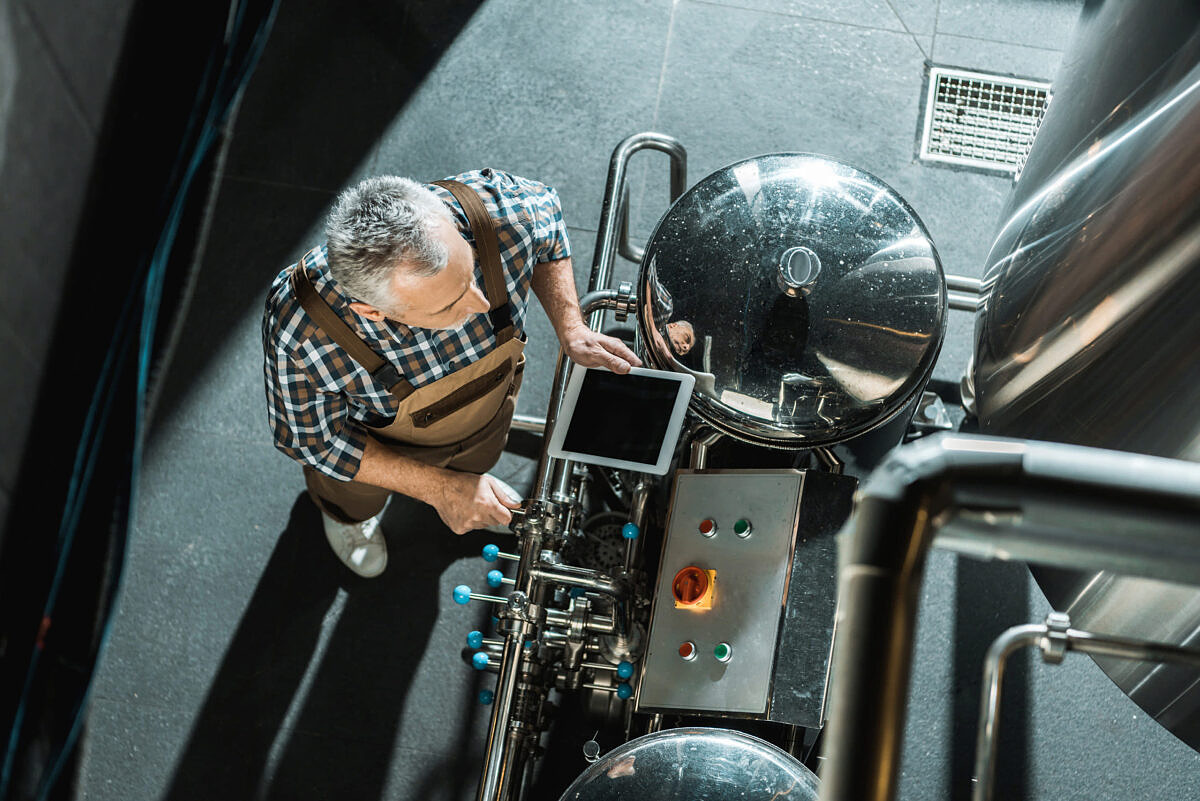Beer Brewing 4.0: digitalization of the brewing industry
A romantic craft? Digitalization has completely revolutionized the art of beer brewing. Join us on the journey and find out how the frothy beverage is made today and what role machine learning, digital twins, and other aspects play.

Cheers 4.0 – can intelligence brew a good beer?
Beer brewing is a millennia-old and much-treasured craft among society. Importantly, it has also moved with the times. The current beer trend is seeing craft breweries sprouting up everywhere along with do-it-yourself guides for a personal brewing experience at home. For some time now, it’s not just large international breweries that are embracing much more than the rules laid down by beer purity regulations. Beer brewing is rapidly becoming intelligent and networked and thus being propelled into the digital era. Do we have anything to gain from this as consumers?
The digital transformation in the brewing trade is thankfully anything but disruptive. Beer doesn’t flow through digital interfaces and isn’t consumed virtually. However, with beer consumption in the United States gradually declining since the 1980s and a similar downswing being observed in other countries, smaller breweries are also feeling the pressure to become more futuristic and be open to the evolving realities of digital progress in all areas of their business – the possibilities and potential of Beer Brewing 4.0 are enormous.
A revolution in beer development: Carlsberg’s Beer Fingerprinting Project
The Carlsberg brewery group has already been using AI since 2017 to optimize the brewing process and the taste experience of the final product. As part of its Beer Fingerprinting Project, which was completed in 2020 in collaboration with Microsoft, Aarhus University, and the Technical University of Denmark (DTU), the Danish group produced hundreds of different beers in extremely small quantities, which were evaluated using sensors and the datasets they recorded. The readings made it possible to determine, for example, whether the brewer’s yeast used would also be suitable for larger production quantities and even what a beer brewed this way would taste like, thereby eliminating the need for human taste tests.
The collected data was analyzed with the help of AI and machine learning algorithms, enabling a “flavor fingerprint” to be simulated and predicted. After just six months, the AI system was able to differentiate between various types of lagers and pilsners and define the specific taste characteristics.
The more data that was generated in the process, the more accurately beer types could be created to ideally meet the taste expectations of consumers in certain situations and for particular occasions. This all revolutionized the development process in breweries.
AI as brewmaster
The first beer to be brewed according to a recipe generated by AI was through IntelligentX’s Automated Brewing Intelligence (ABI). The development process underlying this was incredibly user-centric and didn’t fail to incorporate analog aspects: consumers were able to buy the beers, try them, and rate how they tasted via a chatbot. The data from the ratings was fed into a machine learning algorithm, which then gradually tweaked the recipe based on the consumers’ taste preferences.
AI is thus already capable of
- predicting tastes
- and automatically adapting the product range,
- the necessary production processes,
- and the required production quantity accordingly.
Analytics and big data for the mash
Amateur brewers and beer enthusiasts alike know that mashing is an absolutely critical step when making beer. During the mashing stage, barley and malt are mixed with water so that the enzymes can turn the starch into sugar. It’s a delicate process that is difficult to control because key quality parameters, such as the raw ingredient quality, fluctuate considerably. Even the slightest of temperature variations in the brew kettle at the wrong moment in the mashing process can significantly affect how the final product tastes.
A project entitled “Real-Time Quality Assurance in Food Production: Cyber-Physical Systems and Big Data” was initiated by OWL University of Applied Sciences and Arts in collaboration with SAP’s system house partner “itelligence” with the aim of transforming the complicated mashing process using a closed-loop solution. To achieve the closed loop, complex analytical laboratory procedures were implemented during the mashing process. Sensors integrated into the processing machines and corresponding IT systems for data handling created a digital twin of the final product, allowing modifications to the production process to be safely simulated.
In this way, critical parameters, such as sugar and nitrogen content, could be measured in real time based on the complex data and its analysis, and a prediction could also be made about the beer’s final gravity after the processing stage. Undesired deviations during the process could be counteracted immediately and automatically by adjusting the temperature or volume.
This solution makes it possible to ensure product quality
- predictively,
- reliably, and
- cost-effectively.
Thanks to the closed-loop analytical method, the final product no longer needs to be tested by means of intricate laboratory procedures and the risk of production errors can be completely eliminated.
Beer Brewing 4.0 means always thinking about that “Cheers!” moment
Advances in digitalization and clever concepts are revolutionizing not only the brewing process itself, but also the entire supply chain. Another project championed by Carlsberg is the “connected bar”, where IoT technology gives barkeepers complete and constant control of how much stock they have, how full their casks are, and the temperature of their beer. For Carlsberg’s part, it can access this data to arrange for fresh supplies to be provided to its suppliers as and when they are needed.
The possibilities opened up by a combination of all the tried-and-tested technologies presented here are extraordinary. It’s less about collecting data and more about analyzing it and deriving appropriate actions from the results. The goal of integrated planning should be to cleverly control production on the market and drive demand in the short term. In this sense, the opening of a beer bottle by a bartender or consumer will ultimately be what triggers the sourcing of raw ingredients; the whole of tomorrow’s corporate planning will be determined by today’s demand. All the processes and workflows that come in between must be made agile enough to shorten the time between raw ingredient procurement and sales as much as possible.
That said, tradition-conscious connoisseurs can rest assured that the beer itself cannot be digitalized now or in the foreseeable future. It will continue to be consumed in an “analog” fashion. It simply tastes too good for it not to be. Cheers to that!
If you don’t want to miss any other exciting topics, then subscribe to our content newsletter now and stay up to date.





